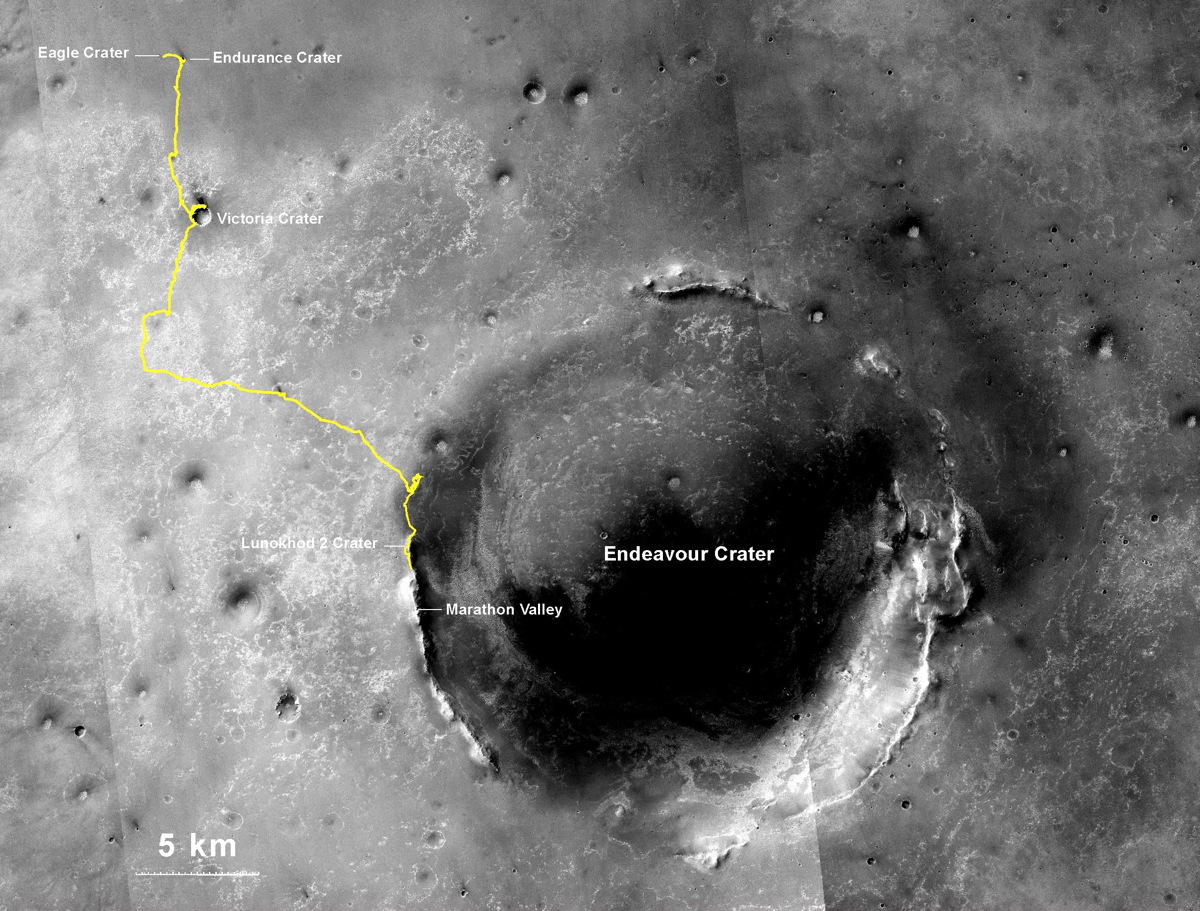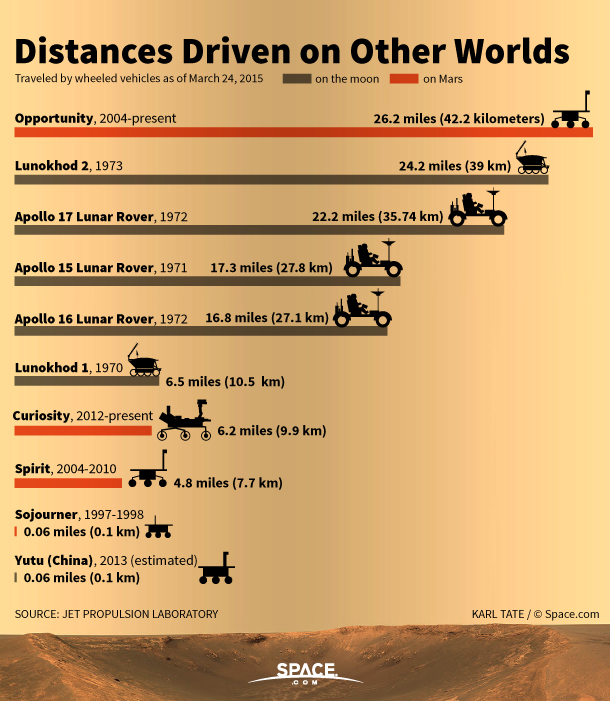NASA's Opportunity rover on Mars has now boldly gone farther than any vehicle has before on the surface of another world, space agency officials announced today (July 28).
As of Sunday (July 27), the Opportunity rover has driven 25.01 miles (40.2 kilometers) on the Red Planet, NASA officials said. The distance record had been held by the Soviet Union's remote-controlled Lunokhod 2 rover, which covered 24.2 miles (39 km) on the moon back in 1973.
"Opportunity has driven farther than any other wheeled vehicle on another world," Opportunity project manager John Callas, of NASA's Jet Propulsion Laboratory in Pasadena, California, said in a statement. "This is so remarkable considering Opportunity was intended to drive about one kilometer and was never designed for distance. But what is really important is not how many miles the rover has racked up, but how much exploration and discovery we have accomplished over that distance." [Distances Driven on Other Worlds (Infographic)]

There has been some uncertainty regarding how far Lunokhod 2 actually went on the moon during its five months of operation in 1973. The lunar rover's record was initially set at 23 miles (37 km), then upped last year to 26 miles (42 km) by a Russian team that analyzed photos of Lunokhod 2 tracks taken by NASA's Lunar Reconnaissance Orbiter (LRO).

But that estimate was revised downward recently, and NASA is confident that Opportunity is indeed now the record holder. An international team has confirmed that the methods used to calculate the two rovers' odometry are consistent and comparable from the moon to Mars, agency officials said.
Opportunity and its twin, Spirit, landed in different parts of Mars in January 2004 on a three-month mission to search for evidence of past water activity. Both rovers found plenty of such evidence, then kept on exploring the Red Planet; Spirit ceased communicating with Earth in 2010, while Opportunity is still going strong today.
Lunokhod 2 helped pave the way for such accomplishments, Opportunity team members said.
Get the Space.com Newsletter
Breaking space news, the latest updates on rocket launches, skywatching events and more!

"The Lunokhod missions still stand as two signature accomplishments of what I think of as the first golden age of planetary exploration, the 1960s and '70s," said Spirit and Opportunity principal investigator Steve Squyres of Cornell University.
"We're in a second golden age now, and what we've tried to do on Mars with Spirit and Opportunity has been very much inspired by the accomplishments of the Lunokhod team on the moon so many years ago," he added. "It has been a real honor to follow in their historical wheel tracks."
Earlier this year, Squyres and his colleagues named a small crater on the rim of the huge Endeavour Crater, which Opportunity has been exploring since August 2011, "Lunokhod 2" in homage to the Soviet robot.
Opportunity will complete an off-world marathon (26.2 miles, or 42.2 km) if it can keep rolling along for another mile or so. If Opportunity makes it that far — and there's no reason to doubt the rover, since mission managers say Opportunity remains in good health despite its advanced age — the six-wheeled robot will get close to a site the mission team has dubbed "Marathon Valley."
NASA's other operational Mars rover, the 1-ton Curiosity, has a long way to go before it can even get within sniffing distance of Opportunity's record. The odometer on Curiosity, which touched down in August 2012, won't click over to double-digit miles for a while yet.
Follow Mike Wall on Twitter @michaeldwall and Google+. Follow us @Spacedotcom, Facebook or Google+. Originally published on Space.com.
Join our Space Forums to keep talking space on the latest missions, night sky and more! And if you have a news tip, correction or comment, let us know at: community@space.com.

Michael Wall is a Senior Space Writer with Space.com and joined the team in 2010. He primarily covers exoplanets, spaceflight and military space, but has been known to dabble in the space art beat. His book about the search for alien life, "Out There," was published on Nov. 13, 2018. Before becoming a science writer, Michael worked as a herpetologist and wildlife biologist. He has a Ph.D. in evolutionary biology from the University of Sydney, Australia, a bachelor's degree from the University of Arizona, and a graduate certificate in science writing from the University of California, Santa Cruz. To find out what his latest project is, you can follow Michael on Twitter.









